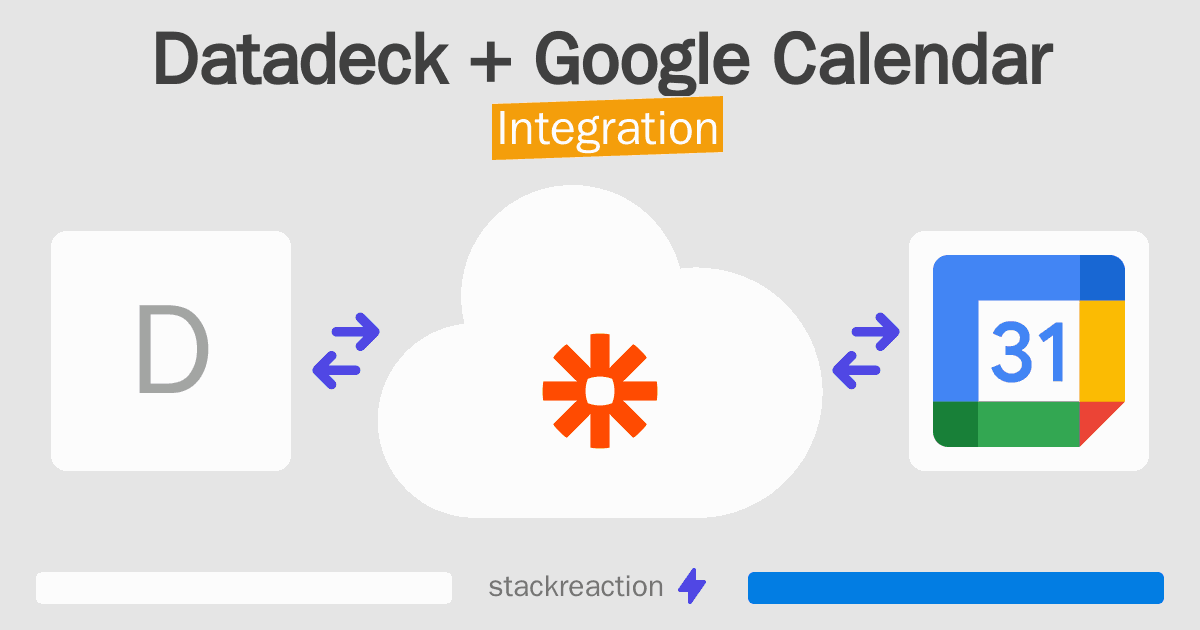How to connect Datadeck and Google Calendar
Datadeck and Google Calendar integration is available through Zapier, a workflow automation tool. With the combination of 1 Datadeck trigger and 95 Google Calendar actions, you can create dozens of integration workflows to automate your work.
Workflow Automation Platforms supported by Datadeck and Google Calendar
You can streamline your workflow processes between Datadeck and Google Calendar with these no-code automation platforms that don't require any coding experience. Browse through this list to find the right platform that enables customized workflows tailored to your specific business requirements.
- Zapier. Zapier simplifies busy people's lives by automating web app data transfers, reducing tedious tasks, and allowing teams to collaborate effortlessly. With over 5,000 popular apps connected, it's never been easier to streamline your workflow.
- Pricing Options
- FreemiumFree Trial
- Starting From
- 30$/month
Datadeck and Google Calendar Integration Price
If you have decided to use a workflow automation tool to connect Datadeck and Google Calendar, it's important to carefully analyze the cost of integration.
For those seeking pricing information on automation services that support Datadeck and Google Calendar integration, we have collected and organized the data for you. Check out our table below for details based on 100, 1K, 10K and 100K basic automations per month.
Basic automation includes only one trigger and one action, making it simple. For instance, creating a record in database every time a task is completed is a basic automation.
| Automation Platform | 100 | 1K | 10K | 100K |
|---|---|---|---|---|
Volume: 100 Plan: Free $0 Volume: 1K Plan: Starter $58.5 Volume: 10K Plan: Professional $193.5 Volume: 100K Plan: Professional $733.5 | $0 Free | $58.5 Starter | $193.5 Professional | $733.5 Professional |
Triggers and Actions supported by Datadeck and Google Calendar
Integrating Datadeck and Google Calendar often involves finding automation that is suitable for your business request.
Automations serve as a workflows that connect your applications, automating a business process. The Trigger acts as the event that initiates the automation, while the Action denotes the executed event.
We've taken great care in collecting every available Trigger and Action from multiple Workflow Automation Platforms, enabling you to evaluate integration possibilities and make an informed decision on connecting Datadeck and Google Calendar.
When this happens
Select a Trigger
No triggers found
Do this
Select an Action
How to setup Datadeck and Google Calendar integration
Step 1: Choose a Workflow Automation Service supported by Datadeck and Google Calendar. Choose automation platform
60 seconds
60 secondsStep 2: Securely authenticate Datadeck and Google Calendar on the chosen automation service before proceeding.
60 seconds
60 secondsStep 3: Choose a Trigger for Datadeck, which will start your automation scenario. Explore Triggers
15 seconds
15 secondsStep 4: Choose an appropriate Action to be executed by Google Calendar once your automation scenario is triggered. Explore Actions
15 seconds
15 secondsStep 5: Set up the data exchange between Datadeck and Google Calendar and configure the parameters to meet your requirements.
120 seconds
120 secondsStep 6: Finalize your integration by testing and publishing it. Voila! Sit back and enjoy the no-code automation.
More integrations to Datadeck
Looking for other automation scenarios with Datadeck? Check out our list of additional popular Datadeck integrations. Datadeck Integrations
More integrations to Google Calendar
Looking for other automation scenarios with Google Calendar? Check out our list of additional popular Google Calendar integrations. Google Calendar Integrations
Datadeck and Google Calendar integration Diagram

Frequently Asked Questions
Does Datadeck integrate with Google Calendar?
- You can connect Datadeck and Google Calendar automatically using no-code Workflow Automation Tool. Use Zapier to link Datadeck and Google Calendar.
Can you Integrate Datadeck and Google Calendar for free?
- Yes, you can use the free plan of Zapier to connect Datadeck to Google Calendar for free, albeit with some limitations.

